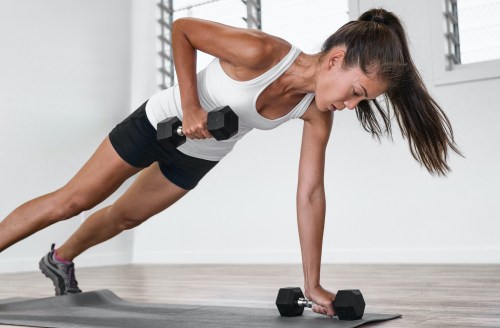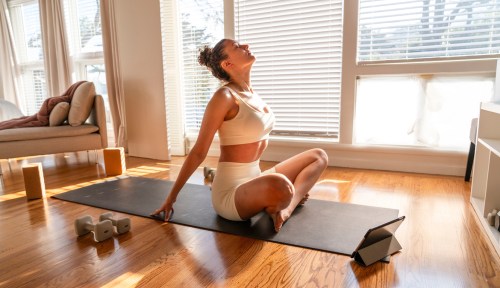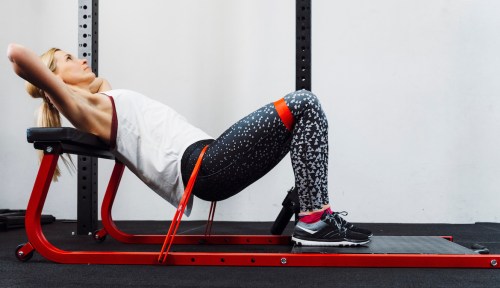For many of us, the dumbbells that have been gathering dust in the garage since 2002 are (sigh) pretty much the closest we’ll get to the weight room for a while. Trainers say that under-estimating what you can do with that set of vintage workout equipment would be a mistake; however, especially right now, when many desk-workers don’t have access to their ergonomic office desk chairs. Repping through a few back exercises with dumbbells to strengthen your spine will make sure you walk out of quarantine with better posture and a stronger posterior chain than you had before.
Experts in This Article
certified personal trainer and signature guide at KINRGY
head of athletics at F45 Training
“The back is not a single muscle group. It consists of the upper back, lower back, middle back, rear shoulders, and many other supporting muscles,” says Johry Batt, head of athletics at F45 Training. “Our back muscles play a huge role when it comes to good posture, especially for those of us who are in front of our computer screens all day and having a strong back will most definitely allow you to perform most movements and daily tasks with ease.”
Alissa Tucker, AKT master trainer, adds that strengthening your posterior chain keeps you from developing body imbalances that may crop up if you’re someone who loves the core workout that a good Pilates or HIIT session can offer you. “The constant rounding forward of the shoulders causes our back muscles to become deconditioned or lengthened while the muscles in the front of our bodies become tight. These imbalances only contribute to worse poor posture and can lead to pain and potential injury,” she says.
When you’re devising a workout that will incorporate your back in equal measure to your front, Tucker recommends thinking about your strength training in terms of push and pull. “At AKT we incorporate a combination of both pushing and pulling exercises to make sure we’re training both sides of the body. Pushing exercises—like push-ups and chest presses, work the front of the body while pulling exercises with resistance bands or dumbbells work the back of the body,” she says. So if your current workout plan is all pull-ups, it’s time to refresh. Below, Tucker and Batt offer two full workouts that will bring your back into the full-body mix. Perform them each once a week, and you’ve got your back covered.
Batt’s full-body and back blaster
This strength-based full-body workout consists of supersets alternating between pulling and pushing exercises as well as weighted and bodyweight movements in each superset. For each set, perform 10 reps of movement A and 20 reps of movement B using an amount of weight that’s challenging, but not impossible for you. Work through each superset three to four times, resting 45 seconds between A and B and two minutes between supersets.
Superset 1
Dumbbell front squats: Hold dumbbells in front of your chest and send hips back and down into a seated position. Maintain a neutral spine throughout and avoid collapsing forward as you squat down. Engage your core to come back up to standing.
Plyometric lunges: Explosively perform jumping lunges with both knees bent to 90 degrees. Maintain an upright chest and send the hips straight down. Drive through the heel to switch sides.
Superset 2
Dumbbell bent-over rows: Lean forward holding the dumbbells straight out with your upper body almost parallel to the floor. Pull the weights towards your body. Maintain a flat back by squeezing the abdominal muscles as you perform the reps.
Bodyweight lying subscapular exercise: Lie face down and extend your arms forward and your legs back. Lift your chest and legs off the ground, and hold this position as you perform a rowing movement squeezing the traps.
Superset 3
Close grip lying dumbbell press: Flip onto your back and hold the dumbbells at your chest. Press them up into the air.
Bodyweight push-ups: Start in a high plank with your hands directly under your shoulders. Maintain a flat back and avoid sagging hips as you perform your push up. Keep your elbows close to your sides.
Superset 4
Dumbbell upright row: Hold the weights at your hips with an overhand grip. Pull your elbow straight up to the sky as much as you can without crunching your shoulders. Release slowly.
Bodyweight lying supermans: Lie face down and extend your arms to the front and legs to the back. Engage your glutes and lower back as you raise your chest and legs off the floor. Hold for two counts then reset and repeat.
Superset 5
Dumbbell Romanian deadlifts: Start standing, holding the dumbbells with an overhand grip. Hinge at the hips sending your butt straight back. Lower your weights to mid-shin and maintain a straight back throughout the movement. Squeeze your quads and glutes as you return to the starting position.
Bodyweight inchworms: Start by bending down, hinging at the hips and knees. Walk forward through the hands into an extended plank and back to starting position.
Superset 6
Dumbbell bicep curls: From standing, use an underhand grip to curl the weight into your shoulders. Avoid swinging the weights and keep your elbows forward and close to your sides.
Bicycle crunches: Lie on your back. Pull your belly button into the floor and lift your shoulders off the ground. Start with your legs at 90 degrees, then extend your left leg and bring your left elbow to the right knee. Alternate side through controlled movement.
15-minute AKT-inspired workout
Repeat each circuit three times. Round one is 30 seconds each exercise, round two is 30 seconds each exercise, and round three is 15 seconds each exercise, really pushing the tempo to get your heart rate up.
Circuit 1
Chest opener jacks: Just complete traditional-style jumping jacks with your palms opening and closing at shoulder height, palms facing in.
Alternating reverse lunges with arm raise: Start with feet together, step one leg back, bending the knees coming into a lunge while lifting the arms overhead.
Roll down plank: Start with the feet together. Clasp hands behind the back, roll the shoulders down, and look up—stretching the chest and front of the shoulders. Unclasp the hands and tuck the chin as you roll down. Walk your hands out to a Plank. Then walk back in, roll up, and repeat.
Sailors with jumping jack arms: Alternate jumping from one foot to the other while extending the opposite leg out to the side. Raise your arms up and down like you’re doing a jumping jack.
Circuit 2
Crab kicks: Begin like you are going to “crab walk” or do tricep dips, lifting the hips and keeping the shoulders away from the ears. Kick one leg at a time alternating sides.
Dumbbell back flies: Stand in an athletic stance: feet hip-distance or wider, hinging forward from your hips about 45 degrees. Open the arms out to the sides, focusing on the middle of the back. Keep the shoulders away from your ears to keep the trapezius as relaxed as possible.
Rotating jump squats: Begin in a squat position with your toes and knees facing forward and your weight in the heels. Jump from the bottom of the squat, turning about 45 degrees in the air to face the other side.
Staggered stance dumbbell power rows: Stand in a mini lunge, hinging forward about 45 degrees. Pull your elbows back, bringing the weights to your hips and hugging the elbows into the body.
Circuit 3
Alternating kickbacks with dumbbell lat pull: Start with your arms overhead, palms facing front. Bend one knee at a time trying to bring your heel to your booty as you pull your elbows down by your sides.
Side kneeling lateral leg lift with lat pull: Begin with one knee on the floor and the same arm as the leg on the floor, directly under your shoulder. Grab one dumbbell in each hand. The top arm will extend overhead while the top leg is straight and the toe is on the floor. Lift your leg as high as you can, keeping it parallel while you bend the top arm, pulling the elbow into your side. Then, lower the leg and stretch the arm back overhead.
Prone tricep raises: Begin lying on your stomach with your arms by your sides and your palms facing up. Roll your shoulders down your back as you use your upper and mid-back muscles to lift your chest a couple of inches off the floor. Lift your arms up and pulse, trying to keep them above your hips. Add dumbbells if you wish, but make sure you pull your belly button to your spine and engage your glutes to support your lower back.
Mountain climbers: Begin in a high plank position with your shoulders over your wrists. Draw one knee in at a time, trying to pick up the pace and get the heart rate up while working the entire core.
Voila: Now you have two, full-body workouts at your fingertips to ring in a week of workouts that will help you gain a stronger spine. “Incorporating back exercises to your weekly routine will play a huge role in your overall physical development and movement,” says Batt. “Focus on developing the major and supporting muscle groups of your back and don’t neglect mobility exercises that’ll improve your range of movement.” I would say that you should really put your back into it—but that would be cheesy.
Also you could try this quick weighted HIIT workout:
Oh hi! You look like someone who loves free workouts, discounts for cult-fave wellness brands, and exclusive Well+Good content. Sign up for Well+, our online community of wellness insiders, and unlock your rewards instantly.
Sign Up for Our Daily Newsletter
Get all the latest in wellness, trends, food, fitness, beauty, and more delivered right to your inbox.
Got it, you've been added to our email list.











